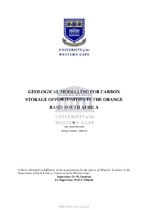| dc.contributor.advisor | Opuwari, Mimonitu | |
| dc.contributor.advisor | Titinchi, Salam | |
| dc.contributor.author | Holtman, Jade Aiden | |
| dc.date.accessioned | 2019-09-30T11:06:57Z | |
| dc.date.available | 2021-09-01T22:10:06Z | |
| dc.date.issued | 2019 | |
| dc.identifier.uri | http://hdl.handle.net/11394/7019 | |
| dc.description | >Magister Scientiae - MSc | en_US |
| dc.description.abstract | This study investigates the viability of the sedimentary deposits in the Northern Orange basin for carbon storage and sequestration. A combination of geological modelling, petrographic and geochemical techniques are used to investigate this scenario after an initial seismic-well tie had been performed to match the formation tops in Well AF-1 with the 3D seismic volume acquired in this basin in 2009. Core description of well AF-1 assisted in identifying different facies and samples taken at specific depths for petrographic and geochemical analyses, while different geological formations were mapped from the calibrated positions of seismic-well tie throughout the seismic volume.
The well data and geophysical logs were utilized to generate petrophysical properties and used to calibrate observations made from seismic interpretations. The facies log used in this study was generated using the Python’s script on Petrel 2014 Gamma Ray, while the density log was used to generate the porosity log. The generated facies and porosity logs were upscaled and used to populate a 3D grid using faults and surfaces identified in the seismic volume. The sedimentological properties of the subsurface were identified utilizing petrographic descriptions including measurements of sorting, colour and grain sizes. While the mineralogical properties of the record was verified through XRD analyses and thin section.
The facies and porosity modelling revealed the dominance of siltstones and sandstones as the main sedimentary facies throughout the sequence. Sandstones are extensive and prominent within the Cenozoic and Mastrichtian, while the unit dated to the Barremian is identified as having the best potential for CO2 storage based on the overlaying capping unit. Quartz, Plagioclase feldspar (Albite), Biotite and Kaolinite are the major minerals identified in all four samples. Each of these minerals has an implication for which may influence the long term storage of CO2 with the potential to form as they may form part of the inra-porous post-depositional cementation and hence change the porosity and permeability properties. The presence of Albite as observed on the XRD may predict possible mineralisation of CO2 to form Dawsonite when reservoir is injected with CO2.
The Barremian sandstone which straddles the Aptian shale at the top and the Hauterivian Shale and Siltsone deposit at the bottom holds a good promise for a potential CO2 storage.
An estimated volume of CO2 that could be stored in the reservoir of the Barremian sandstone in zone 8 is limited to the lateral seal of shale above the reservoir in zone 7 of the Aptian age.
The method used to determine the potential storage capacity of CO2 was performed by Alexandros Tasianas and Nikolaos Koukouzas (2016). The Equation used to determine CO2 storage capacity is: mCO2 = RV * Ø * Sg * δ(CO2) . | en_US |
| dc.language.iso | en | en_US |
| dc.publisher | University of the Western Cape | en_US |
| dc.subject | Orange basin | en_US |
| dc.subject | Carbon | en_US |
| dc.subject | Sequestration | en_US |
| dc.subject | Siltstones | en_US |
| dc.subject | Sandstones | en_US |
| dc.title | Geological modelling for carbon storage opportunities in the Orange Basin South Africa | en_US |
| dc.rights.holder | University of the Western Cape | en_US |

